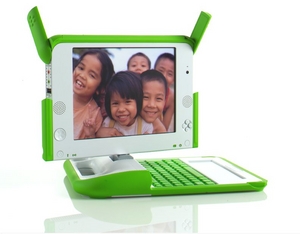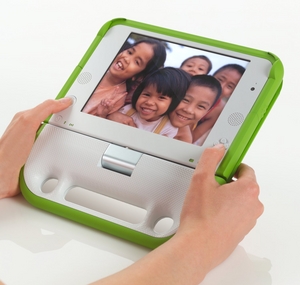XO: The Children's Machine
Introducing the children's laptop from One Laptop per Child, a potent learning tool created expressly for the world’s poorest children living in its most remote environments. The laptop was designed collaboratively by experts from both academia and industry, bringing to bear both extraordinary talent and many decades of collective field experience in every aspect of this non-profit humanitarian project. The result is a unique harmony of form and function; a flexible, ultra low-cost, power-efficient, responsive, and durable machine with which nations of the emerging world can leapfrog decades of development—immediately transforming the content and quality of their children’s learning.
Unlike any laptop ever built
The laptop is not a cost-reduced version of today's laptop; we have fundamentally reconsidered personal computer architecture—hardware, software, and display. Unlike any laptop ever built, the laptop:
- Creates its own ad-hoc network out of the box. Each machine is a full-time wireless router. Children—as well as their teachers and families—in the remotest regions of the globe will be connected both to one another and to the Internet.
- Features a 7.5-inch, 1200×900-pixel, TFT screen and self-refreshing display with higher resolution (200 DPI) than 95% of the laptops on the market today. Two display modes are available: a transmissive, full-color mode; and a reflective, high-resolution mode that is sunlight readable. Both of these modes consume very little power: the transmissive mode consumes one watt—about one seventh of the average LCD power consumption in a laptop; and the reflective mode consumes a miserly 0.2 watts.
- Can selectively suspend operation of its CPU, which makes possible further remarkable power savings. The laptop nominally consumes less than two watts—less than one tenth of what a standard laptop consumes—so little that laptop can be recharged by human power. This is a critical advance for the half-billion children who have no access to electricity.
Free software
To enhance performance and reliability while containing costs, The laptop is not burdened by the bloat of excess code, the “feature-itis” that is responsible for much of the clumsiness, unreliability, and expense of many modern laptops. We intend for laptop to start up in an instant—faster than any commercial laptop now available—and move briskly through its operations.
The laptop is an open-source machine: free software gives children the opportunity to fully own the machine in every sense. While we don't expect every child to become a programmer, we don't want any ceiling imposed on those children who choose to modify their machines. We are using open document formats for much the same reason: transparency is empowering. The children—and their teachers—will have the freedom to reshape, reinvent, and reapply their software, hardware, and content.
The generation-one machine’s core electronics begin with the 433Mhz AMD Geode processor. There are 256MB of dynamic RAM and 1GB of SLC NAND flash memory on board. The basic integrated operating system is a “skinny” Fedora distribution of Linux. The user interface is specially designed to support collaborative learning and teaching: every activity comes with a support network of teachers and children, so learning need not be an isolated, lonely endeavor.
Features
Each machine features a video/still camera, two external USB-2.0 ports, plus an SD slot.
The laptop is VOIP-enabled, creating another link among users (both locally and globally). It features CSound, an incredibly powerful and versatile music synthesis software that takes advantage of a full-featured audio codec (and the local network for collaborative musical performances). There are internal stereo speakers, as well as a stereo line-out jack. The microphone is built in, with a mic-in jack, which offers another unique feature: “sensor input” mode. The children can plug in a number of sensors, enabling them, for example, to turn their machines into thermometers or oscilloscopes.
Form factor
Form factor was a priority from the start: the laptop could not be big, heavy, fragile, trivial, ugly, dangerous, or dull. Another imperative was visual distinction. In part, the goal is to strongly appeal to the laptop’s intended users; but the machine’s distinctive appearance is also meant to discourage gray market traffic. There’s no mistaking what it is and who it is for.
The laptop is about the size of a textbook and lighter than a lunchbox. Thanks to its flexible design and “transformer” hinge, the laptop easily assumes any of several configurations: standard laptop use, ebook reading, and gaming.
The laptop has soft, rounded edges. The integrated handle is kid-sized, as is the sealed, rubber-membrane keyboard. The touchpad supports pointing and dragging.
Safety and reliability
The laptop is fully compliant with the European Union’s RoHS Directive. It contains no hazardous materials. Its batteries (NiMH or LiFePo4) contain no toxic heavy metals, plus it features enhanced battery management for an extended recharge-cycle lifetime. It will also tolerate alternate power-charging sources, such as car batteries.
To top off the battery—for use at home and where power is not available—the laptop can be hand powered. It will come with at least two of three options: a crank, a pedal, or a pull-cord. It is also possible that children could have a second battery for gang-charging at school while they are using their laptop in class.
Experience shows that the laptop components most likely to fail are its hard drive and internal connectors. The laptop has no hard drive to crash and very few internal cables. For added robustness, the machine’s plastic walls are 2.0mm thick, as opposed to the standard 1.3mm. Its antennas, which far out-perform those of the typical laptop, double as external covers for the USB ports, which are protected internally as well. The display is also cushioned by internal “bumpers.”
The estimated product lifetime is at least five years. To help ensure such durability, the machines will be subject to factory testing to destruction as well as in situ field testing by children.
A real computer
Some computer industry figures have publicly dismissed the laptop as a stripped-down toy—a gadget. “Geez”, asked one, “why not get a real computer?” Indeed. These individuals certainly now know better: as a not-for-profit, we have done something out of their reach—something for the children of the world. Comments and critiques are, of course, always welcome at laptop.org.
See also
- specifications for the original XO-1 laptop,
- the XO-1.5 laptop,
- the XO-1.75 laptop,
- the XO-4 laptop,
- the introduction to the laptop at http://laptop.org/laptop ,
- Geekdad on The road ahead

